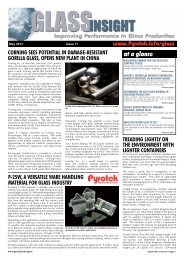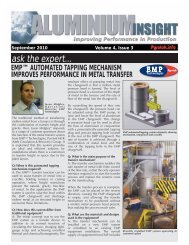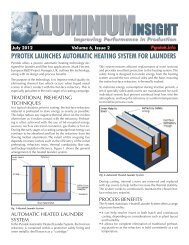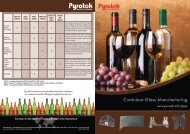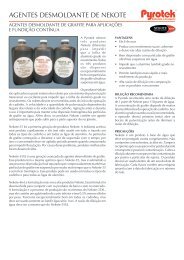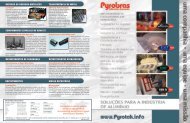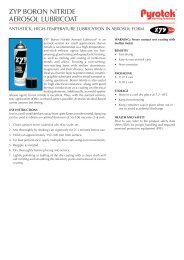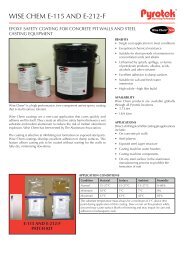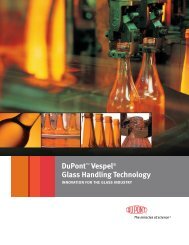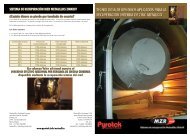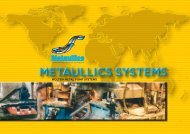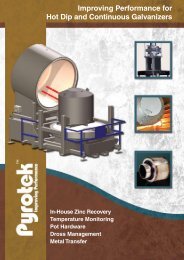Bonded Particle Filter - Pyrotek
Bonded Particle Filter - Pyrotek
Bonded Particle Filter - Pyrotek
Create successful ePaper yourself
Turn your PDF publications into a flip-book with our unique Google optimized e-Paper software.
BONDED PARTICLE FILTERS FOR MOLTEN ALUMINIUM
METAULLICS SYSTEMSMetaullics Systems, headquartered in Solon, Ohio, USA is adivision of <strong>Pyrotek</strong>, Inc., which is a privately owned company withheadquarters in Spokane,Washington, USA.<strong>Pyrotek</strong> specialises in the development, manufacture and supply ofhigh temperature materials, technologies and engineered systemsfor liquid metal management and associated metallurgicalapplications. Manufacturing units and sales offices are located inmore than 60 worldwide locations and allow <strong>Pyrotek</strong> to offeroutstanding customer service and supply logistics. Productsinclude launder systems, distribution bowls, tundishes andspecialised insulating shapes and filters.Metaullics is a global supplier of molten metal pumps, distributionsystems, alloying systems and scrap and waste recovery systems,filtration systems for all sectors of the Aluminium industry.Metaullics Systems Europe, with headquarters in The Netherlandsprovides local application engineering, customer service andwarehousing facilities for Europe and The Middle East.1. SUPERIOR FILTER MEDIAFROM METAULLICSIt gives you the benefits of clean aluminium – reliably andeconomically.Molten aluminium normally contains various solid-phaseinclusions, such as oxides, borides, carbides and spinels, andrefractory particles from vessel erosion. If allowed to remain,these contaminants adversely affect the characteristics of themetal in its final, solidified form.Impact of Inclusions on Final Product QualityReduced extrusion die lifeSurface streaksin brightautomotivetrimPoorsurfacefinishFlangecracks inbeverage cansInclusionGeneratedDefectsReduced mechanical strength, ductility, fatige resistanceEffective filtering of molten (liquid) aluminium removes thesecontaminants and can also reduce inclusion-nucleated porosity.This not only improves product quality and lowers the reject rate,creating additional profit to cover the cost of filtration. In fact,filtration always adds value—never just cost!However, with some commercially available filters, problems likerapid head build-up, sudden contaminant release (dumping), filterbreakage and even ineffective or unreliable filtration can occur.Precaution requires the use of superior media, plus special knowhowand applications expertise to lower the effective cost ofaluminium filtration and achieve maximum benefit.Poor machineabilityReducedbrightnessinanodisedproductsPinholes inlightgauge foil
At Metaullics, we analyse your process in detail. Only then can wedetermine the correct filter and specify the proper shape, size andpermeability for your specific application. Once this has beendone, you can expect trouble-free service life from yourMetaullics® filters.The media we use, bonded ceramic particulate,provides high filtration efficiency and excellent structural strength.Our media is used in selected wrought casthouse applications toproduce semi-finished shapes, and in aluminium gravity casting(permanent mold), pressure diecasting, low pressure, squeeze castand high-performance sand foundries.Because filtration of aluminium is a complex subject, we hope theinformation in this brochure will prove useful. Let’s begin with alook at what effective filtration should accomplish for you1.1 INCLUSIONS TO BE REMOVEDFiltration is the separation of solids from liquids. Effective filtrationshould trap and hold the major contaminants that are commonlyfound in molten aluminium. Oxides of aluminium and magnesiumare among the inclusions most frequently encountered. Of theseAl2O3 is the most troublesome, because it is the most easilyformed, hence, the most abundant. Furthermore, many inclusionshave an effective specific gravity close to that of molten aluminiumand tend to stay in suspension. Spinel, another kind ofcontaminant, is a complex oxide with a specific crystal structureand the general chemical formula of AB2O4 where A and B aremetals. Common examples of spinels are MgAl2O4 and MnAl2O4.Other inclusions to be found include carbides (especially fromprimary aluminium production), nitrides, and refractory particlesfrom wear and erosion. In foundry alloys, especially diecastingmetal, intermetallic sludge particles (Fe-Mn-Cr complex) cancause ‘hardspots’ which cause machining difficulty. Additionally,recycled metal in any remelt operation always contains substantialoxide content
2. DEPENDABLE METAL CLEANLINESS WITHOUT PROBLEMSDEMANDS DEPENDABLE FILTER MEDIA2.1 WHAT FILTERING DOES FOR METAL QUALITYWhen effective, filtration substantially improves product uniformity.Figure 1a and 1b show the difference between a filtered andan unfiltered aluminium foil product.Figure 1a.Unfiltered aluminiumfoil product metalat 350X.Figure 1b.Foil alloy filteredthrough 10 gritMulticastMC-6 filter.Magnification 350X.With fewer casting defects, your yield and productivity are higher,as is overall product quality.Mechanical properties (tensile, yield, fatigue, creep and rupturestrength) can often be improved with filtration, but elongationor ductility is especially sensitive to metal cleanliness, i.e. lowinclusion levels achieved with filtration means higher ductility. Forexample, in extrusion billet casting, as shown in figure 2, thepercentage of elongation can be greatly increased, even doubled insome cases.Improved surface finish results from inclusion removal, importantfor bright trim stock, cast wheels, or for any other surface finishingoperations (anodizing, painting and plating). Filtration also reducesthe rate of rejection and rework due to pinholes, linear defects ortear-out in foil and sheet product production.Figure 2.Effect of filtration onshort transverseelongation of 7079-T6.<strong>Filter</strong>ing the molten metal results in significantly increased fluidity,which improves castability and helps to prolong mold life.Since inclusions, or hard spots, are minimised or eliminated, themetal is easier to form or machine and tool wear is reduced.
Filtration is especially beneficial in removing ‘hardspots’ (oxide andsludge inclusions) from net and near-net-shape foundry castings,resulting in significantly increased machinibility, less tool wearand less tool breakage! Clearly, gains in product quality, productivityand profitability make filtration a very necessary and desirableprocess for all aluminium casting applications.2.2 COMMERCIALLY AVAILABLE FILTER MEDIAFour major types of filters for aluminium are found in themarketplace. Along with their predominant characteristics, theyare the following:A. Alumina bed filtersBed filters are comprised of ‘layers’ of tabular and ball alumina tocreate ‘depth’ as the metal flows between the ‘balls’ and flakes.The porosity of the bed is not fixed, however, so channelling of thealuminium flow can occur, either spontaneously through surgeflow, or inadvertently through mechanical disturbances. This canlead to dumping of already-trapped inclusions and discharge ofunfiltered metal. While deep-bed filters are usually large and fairlycostly, they do provide excellent filtration if the life is not overextended.B. Ceramic foam filtersCeramic foam filters are bonded or sintered alumina withporosity controlled during manufacture to provide a gradationof pore sizes 20 or 30 ppi, or grades 40, 50, 60, 65 and 80. Withhigh average porosity (80-85%), fairly rapid metal flow rates can beachieved, but at the expense of filtration efficiency. With such highporosity, mechanical strength is relatively low, and handlingdamage or break-up may occur during melt flow. Providing theproper filter grade/flow relationship is maintained for an initialmetal cleanliness, ceramic foam filters are low-cost and find theirbest application as a single-use (single-cast) application in thecasthouse or foundry.C. <strong>Bonded</strong> ceramic particlesThis is the type of filter supplied by Metaullics - a bonded granularceramic media, fabricated either from aluminium oxide or siliconcarbide. The proprietary bonding agent employed is both strongand resistant to chemical attack by molten aluminium.Substantially lower porosity (nominally 40%) and the inherentproperties of the hard alumina or silicon carbide granulesprovides a much stonger filter structure which aids in handlingand durability. Especially with silicon carbide construction, thermalconductivity is substantially higher which aids in preheat and inthermal transfer. The complex, fully-interconnected internal porestructure provides a ‘tortuous path’ for metal flow. The bondingagent also has a particular affinity for inclusions. This combinationof lower porosity, tortuous flow path and binder chemistry allowsthe Metaullics bonded particle filter to exhibit the best balancebetween cake-mode and depth-mode filtration.
D. Other filter mediaIn addition to the preceding filter types, woven fiberglass andextruded ceramics may be used to filter aluminium.Non-rigid fiberglass socks or screens provide very coarsefiltration through a sieve-like action. Inexpensive, they are usedprimarily as a coarse pre-filter after a taphole or where necessaryto remove only the largest contaminants.Extruded ceramics have direct-channel openings where the outletarea is the same as the inlet area. Accordingly, they are used morefor flow control and removal of large inclusion particulate, but arenot very effective for many of the smaller but still undesirableinclusions often existing in aluminium melts.Figure 3 compares the features of the various filter types:2.3 HOW FILTRATION WORKSFiltration involves the science of separating solid particles from aliquid stream as the metal flows through a porous body. All threedimensionalfilters function to various extents through cake-mode(inclusion capture on the filter inlet surface) and depth-mode(filtration within the body of a filter). In Metaullics filter media, filtrationtakes place by an excellent balance between these two modes.Figure 4.Illustrates the liquidflow (main arrow) andshows solid particlescarried by variousforces to the surfacesof the grains.HighTemperatureStrengthGeometricShapesAvailableCoarse Fine Thermal ResistanceFiltration Filtration Conductivity to DumpingMetaullicsMedia+ + + ++(SiC)+<strong>Bonded</strong>Ceramic - - + - - -FoamAluminaBedsWovenFibersN/A - + + - -N/A - + - - -Figure 3. Characteristics of filter media.With the Metaullics bonded particle filter, the aluminium caster oftenhas greater flexibility in achieving filtration efficiency objectives thanwith other types of filters.Figure 5a and b.Depth filtrationvs cake.
Attachment forces are equally important but largely selfexplanatory.Any or all of the following may come into play intrapping and retaining particles on the grain surfaces:- Gravity and/or friction- Physical entrapment (in pockets or crannies)- Van der Waals forces (intermolecular attraction)- Chemical bonds- Electrostatic forcesThe Metaullics filter media contains a proprietary binder whichexhibits a special affinity for inclusion attachment through theseIn depth filtration, inclusions are removed by a two-step capturemechanism - transport from the liquid metal flow and attachmentto the grain surfaces. Strong attachment forces are essential toprevent the suspended solids from being swept away, which couldlead to the dumping of contaminants back in to the filtered metal.Some of the transport forces that come in to play are illustratedin figure 6. Inertia, shown at (a), tends to keep solid particlesmoving in a straight line wherever the liquid flow turns.When thedirection is downward, the effect of gravity causes sedimentation,especially at lower fluid velocities.Direct interception or impingement, diagrammed at (b) occurswhen inclusions collide with protrusions in the grain surfaces.Theeffect of fluid dynamics appears at (c). Resistance offered by theirregular surfaces makes the flow slower at the edges than in thecentre of the liquid stream and solid particles tend to be drawninto the slower flow and deposited on the surface.mechanisms.Figure 6.Major transport forces in depth filtration.a. inertia, sedimentation, b. direct interception,c. fluid dynamics
2.4 HIGH-EFFICIENCY FILTRATIONHigher efficiency filtration is achieved with a lower-porosity, more tortuous path filter body - exactly what the Metaullics bondedparticle filter provides. A tortuous flow path within the filter body permits the fluid stream to thoroughly remix, and each thoroughre-mixing of the stream increases the amount of inclusions captured. This high filtration delivers aluminium clean enough for criticaluses like aerospace, can stock, bright trim, thin foils, fine wire or intricate and highly machined castings.Deep-bed filters can be very efficient under best operating conditions and 95% averageremoval efficiency for all particles has been claimed. Data for ceramic foam filters showefficiencies greater than 80% for coarse particles (over 50), but only 30-60% for finerparticles (25/50). Filtration efficiency for bonded particle filters compares veryfavourably in grade-for-grade comparison.Figure 7 presents a 6 grit bonded particle filter’s efficiency as measured by matrixdissolution and Coulter counter particle analysis, compared with data from publishedsources on a 30 ppi ceramic foam filter.In general, the filtration efficiency for the full range of grit sizes of bonded particle filtersavailable is shown in figure 8 as a function of metal flow rate and of a wide variety ofcasting applications.Figure 7.Figure 8.
3. SUPERIOR FILTER MEDIA... FORMS AND PROPERTIES3.1 PROPERTIES AND PARAMETERSMetaullics filters are manufactured in a wider range of shapes and pore sizesthan any other media. Pore diameter is determined by the size of the grit usedto construct the media, and also determines the flow rate capability, size ofinclusion removed and starting head. Figures 9 to 12 portray these relationships.Figure 9.<strong>Bonded</strong> partical filterpore diametercomparisons.3.2 PHYSICAL PROPERTIES OF METAULLICS BONDEDPARTICLE FILTER MEDIACompositionAl2O3 or SiCApparent density2.2-2.3 grams/cm 3 (Al2O3)Average porosity Approximately 40%Available grits 6 - 30Pore diameters 0.063” 0.012” (1600 - 350)Max. preheat temperature 890°C (1634°F)Max. working temperature 815°C (1500°F)MOR at 750°C450 psi 20 grit Al2O3300 psi 8 grit SiCFigure 10.Aluminium permeabilityfor Metaullics filtermedia as a function ofgrit size.Figure 11.Starting-headrequirements forMetaullics media.Figure 12.Pore diameters ofMetaullics media.
4. METAULLICS BONDED PARTICLE FILTER PRODUCTS1 2 3 4CASTHOUSE APPLICATIONS1. CARTRIDGE FILTER MCF• Recognized as the superior filterconfiguration for premium productwrought application such as canstock,fine foil, lithographic sheet, electronics• Originated by Metaullics over 35 yearsago• Standard tube assemblies available -7, 11, 14, 18, 22, 28 to meet a spectrumof casting flow rate requirements• <strong>Filter</strong> grades 11, 14, 16, 18, 20, 24 grit2. TROUGH TUBE FILTER• Lower cost ‘cartridge’ or tube filtrationspecifically designed for continuouscasting• Capability to 200 lb/min (90 kg/min)casting flow rate with 20 grit• Produce 6 micron foil• <strong>Filter</strong> change-out and restart in lessthan two hours3. MULTICAST FILTER ELEMENT• Best quality and cost/ton filter optionfor many applications• Lower cost/ton than ceramic foam filter• Holds metal ready-at-temperature forcasting between casts• Integrated handling system for easyfilter change• Extended filter life (several hundredtons) and 1 hour filter change-over4. DUAL VERTICAL GATE FILTER• Dual usage filter capability , ideal forwide range for continuous castingoperations• Vertical filtration mode• Compact unit, easy filter change-over• Extended filter life (several hundredtons) for lowest filter cost/ton• Heated unit available with overheadheating or immersion heating• Integrated filter handling systemFOUNDRY APPLICATIONS5. VERTICAL GATE FILTER (VGF)• No capital investment or furnacemodification required• Easy application for melting and castingfurnaces - no furnace draining required• Separates dipwell from heatingchamber• Normal filter life 2 - 3 months, minimalmaintenance6. METAULLICS BOX FILTER (MBF)• Designed for many sizes toaccommodate specific manual orauto-ladling space requirements incasting furnaces and provide point-ofpour-filtrationfor permanent mold orpressure diecasting• Useful when melting and pouring froma single vessel• Supported by legs or by stud/clampedspanner bars on furnace sill• Normal filter life 2 - 4 monthsdepending on filter grade
5 6 7 8 97. FILTER PUMP• Provides first-stage filtration in centralmelting or re-melt furnaces• Transfer filtered metal betweenfurnaces• Fill ladles without entraining re-meltfurnace sludge or dross• Minimise superheat required toaccommodate tap and transfer timelags• Overcome barriers to gravity flow• Prevent carry-over of sludge and otherre-melt debris• <strong>Filter</strong> life dependent on usage andoverall metal cleanliness8. STALK TUBE FILTER• Direct filtration each cycle in lowpressure casting• Significant reduction in inclusion-related• Many shapes and designs available toaccommodate stalk (riser) tube and LPfurnace designs• <strong>Filter</strong> life can be matched to stalk tubelife if cast iron or fused silica is used.<strong>Filter</strong> can be changed without damaginghigher performance ceramic stalk tubes• Resists erosion of stalk tube duringmold filling9. CYLINDER FILTER• Used with low pressure castingfurnaces in wheel and otherautomotive production• Surrounds stalk tube, does not requireconnection and does not depend onstalk tube life or change-out• Easily maintained• 8-12 week filter life for maximumfiltration economy10. CRUCIBLE BAFFLE FILTER• Separates pour-in section from ladlingor dip-out section• Achieves filtered product quality incasting crucibles and when melting andcasting from the same crucible if metallevel and temperature are maintainedrelatively constant• Useful when space constraints do notpermit use of MBF• <strong>Filter</strong> held in position with fixed lugs oncrucible ID• <strong>Filter</strong> change-out and crucible re-useare attained with minimal effort11. DOSING FURNACE FILTER• Creates filtration directly in dosingfurnaces• <strong>Filter</strong>s installed onto the ceramicdosing tube with special gasketing1011scrap for cast wheels and other high• Nominal 3-5 week lifeperformance castings• Spent filters removable from dosingtube for dosing tube re-use.
Metaullics Systems Europe B.V.Ebweg 142991 LT BarendrechtThe NetherlandsTel.: +31 180 590 890Fax: +31 180 551 040metaullics.info@pyrotek-inc.comwww.metaullics.comMetaullics Systems Division, <strong>Pyrotek</strong>, Inc.31935 Aurora RoadSolon, Ohio 44139United StatesTel: +1 440 349 88 00Fax: +1 440 248 34 32metaullics.info@pyrotek-inc.comwww.metaullics.com© Metaullics 2007M3000E



